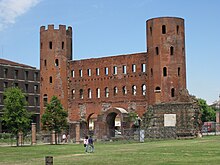Porta Palatina
The Porta Palatina is the only preserved city gate of Roman Turin ( Augusta Taurinorum ). Although it is only a city gate, the plural Porte Palatine is commonly used. The Porta Palatina is the most important surviving archaeological evidence of Roman Turin.
The Porta Palatina formed the northern city gate of Augusta Taurinorum, the Porta Principalis Dextra, through which the road from north to Turin led to the cardo maximus , the north-south road, the ancient city.
history
The city gate was built during the reign of Emperor Augustus in the early 1st century AD. In the 6-7 In the 19th century, supposedly expanded to a palace of the Lombard dukes, the repeatedly rebuilt and expanded complex served as a prison from 1724 and thus escaped demolition, from 1860 the Roman core was exposed again, in the early 20th century the Porta Palatina was built according to plans by the architect Alfredo d'Andrade (1839–1915) restored and reconstructed.
Surname
The etymology of the name Porta Palatina is controversial, some seems to indicate that in Roman or possibly Lombard times there was a palatium , i.e. H. a mansion was located, if not identical to the renovation of the gate itself. From documents from the 11th century, the name Porta Doranea or Porta Doranica is passed down after the nearby river Dora Riparia .
description
The gate is made of bricks ( opus latericium ). Between two more than 30 m high polygonal watchtowers crowned with battlements extends a central component, about 20 m long and 18 m high, called the Interturrio . At ground level there are two large arched gate entrances for carts in the middle and two smaller entrances for pedestrians to the right and left. All gate openings are equipped with grooves as guides for portcullis . There are arched windows on the floor above and straight windows on the upper floor.
Surroundings
Two bronze statues of Julius Caesar and Emperor Augustus placed in front of the gate are modern copies based on ancient models. The surrounding green area (parco archeologico) has remained undeveloped for monument protection reasons, stones of a paved road with remains of ancient ruts are still recognizable. Towards the cathedral, substructures of a small Roman theater from the 1st century AD have been excavated.
More Roman city gates of Turin
The structure of the Porta Palatina corresponds to the two other well-known Roman city gates of Turin, the Porta marmorea , which was destroyed in 1635 but is known from a drawing by Giuliano da Sangallo , and the Porta Decumana , of which remains are still in the Palazzo Madama in Turin can be seen.
Individual evidence
- ^ Heinz Schomann: Piedmont - Liguria - Aosta Valley. Art monuments and museums (= Manfred Wundram [Hrsg.]: Reclams Art Guide Italy . I, 2). Philipp Reclam jun., Stuttgart 1982, p. 422 .
literature
- Pietro Buscalioni: La porta "Principalis Dextera" di Torino romana detta volgarmente Porta Palatina . Turin 1908.
- Goffredo Bendinelli: La Porta Palatina. Monumento capitale di romanità in Piemonte . In: Torino. Rassegna mensile della città 15, 1, 1935, pp. 7-24 ( digitized version ).
